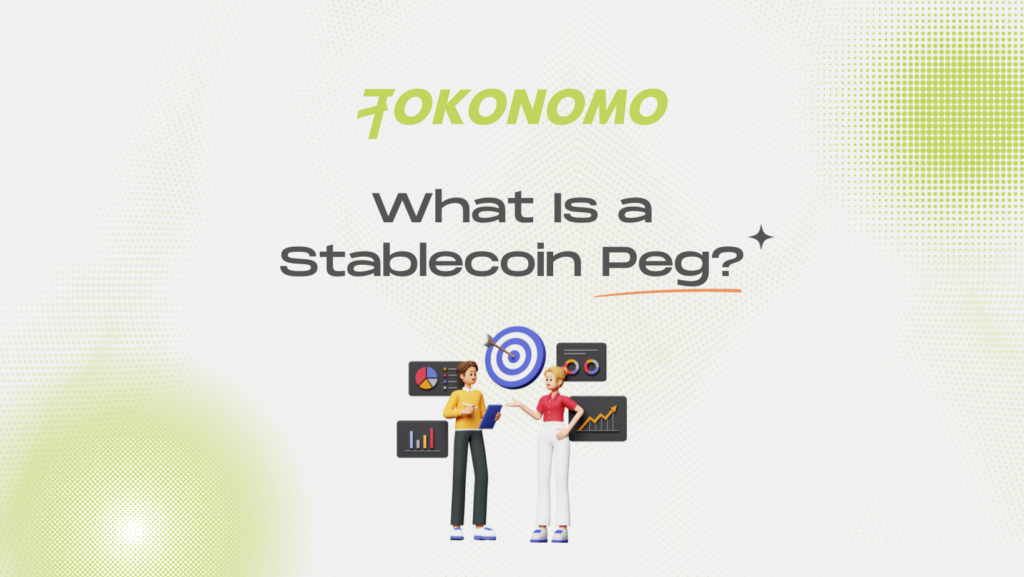In the ever-evolving world of cryptocurrencies, stablecoins have emerged as a vital bridge between the digital and traditional financial realms. These digital assets are designed to maintain a stable value, often pegged to a specific fiat currency, such as the US dollar. However, stability is not always guaranteed, and in this article, we will delve into the intricate dynamics of stablecoins and explore the factors that can cause them to lose their peg. From market forces and regulatory changes to the mechanics of the stablecoin itself, we will unravel the complex forces at play in this fascinating corner of the cryptocurrency ecosystem.
What Is a Stablecoin Peg?
A stablecoin is a specific kind of cryptocurrency asset engineered to maintain a relatively constant value. Unlike conventional cryptocurrencies, which are frequently subject to substantial price fluctuations, stablecoins are meticulously crafted to act as a safeguard against these price swings.


To achieve stability, stablecoins employ a mechanism known as a “peg,” which functions as a value anchor. Analogous to how some nations link the value of their currency to that of another country’s currency to uphold stability, stablecoins utilize a comparable approach. A number of well-known stablecoins, such as USDT and DAI, strive to sustain a value equivalent to $1.
What Occurs When a Stablecoin Loses Its Peg?
When a stablecoin deviates from its predefined peg value in trading, it undergoes what is known as a ‘depegging event.’ The utility of stablecoins has grown significantly over time, currently contributing to daily trading volumes worth billions of dollars. This underscores the significance of a depegging event, as it can potentially trigger extensive ramifications. In the subsequent sections of this article, we will examine historical occurrences of stablecoin depegging, but prior to that, let’s delve into the mechanisms through which stablecoins maintain their pegs.
How Does a Stablecoin Maintain Its Peg?
Stablecoins typically belong to one of two main categories – collateralized and non-collateralized.
- Collateralized stablecoins The majority of stablecoins currently in circulation are classified as collateralized stablecoins, which means that their values are supported by underlying assets. These stablecoins are designed to be underpinned or “collateralized” by fiat currencies, other cryptocurrencies, or tangible assets such as gold. In such instances, each stablecoin issued is theoretically expected to have a corresponding asset reserved as a backing.


Here’s an explanation of how they operate:
- Fiat-collateralized: Each token in circulation is meant to be backed by an equivalent amount of fiat currency, such as the US dollar. Consequently, each individual stablecoin issued should be redeemable for the underlying asset. Notable examples of fiat-collateralized stablecoins include FDUSD and USDT.
- Crypto-collateralized: These stablecoins are secured by an overabundance of a cryptocurrency asset or a collection of crypto assets. This means that more cryptocurrency is held as collateral than the value of the stablecoin, thereby offering a safeguard against potential price fluctuations. DAI and crvUSD serve as illustrations of crypto-collateralized stablecoins.
- Commodity-collateralized: These stablecoins are pegged to the value of commodities like gold. Such coins potentially act as a hedge against inflation and provide exposure to the underlying commodity. Pax Gold (PAXG) is an instance of a commodity-collateralized stablecoin, with gold serving as its backing.
It’s important to note that while stablecoin projects often make assurances regarding their reserves and pegging mechanisms, the verifiability and accuracy of these claims can vary. Therefore, it is essential to exercise caution and recognize that the level of collateralization may not always be 100% as proclaimed.
- Non-collateralized stablecoins Non-collateralized stablecoins also referred to as algorithmic stablecoins, employ coded algorithms and smart contracts to autonomously adjust their supply in response to market demand, ensuring that the stablecoin’s price closely aligns with its peg.


When the price of these stablecoins falls below the value of the fiat currency they track, the algorithm decreases the circulating supply with the aim of driving the price back up. Conversely, if the price surpasses the value of the fiat currency, new tokens are introduced to bring down the stablecoin’s value. TerraUSD (UST) was an example of an algorithmic stablecoin.
So, what happens when these stablecoins lose their pegs and commence trading at a value below their market value? Let’s delve into some instances to illustrate.
Past Occurrences of Stablecoin Decoupling from Their Pegs
Here are some of the most notable instances of stablecoin depegging:
- May 2022 – UST
In May 2022, the cryptocurrency landscape witnessed a momentous event as Terra’s UST stablecoin underwent a historic depegging. Prior to this occurrence, Terra’s native token, LUNA, held the title of the 8th largest cryptocurrency globally, boasting a substantial market capitalization of $40 billion. This depegging incident left both UST and LUNA with almost no value, setting off a chain reaction referred to as the “crypto contagion.” This contagion entailed significant losses for numerous interconnected crypto projects and businesses associated with Terra. During this turbulent period, other stablecoins like Tron’s USDD and Near Protocol’s USN also temporarily lost their pegs before eventually returning to their intended value

- March 2023 – USDC and DAI
In March 2023, two prominent stablecoins, USDC and DAI, experienced depegging events due to the financial turmoil resulting from the collapse of three U.S. banks: Silicon Valley Bank (SVB), Signature Bank, and Silvergate Bank. The issuer of USDC, Circle, disclosed that a significant portion of the cash reserves supporting the stablecoin were held at SVB, leading to a temporary loss of its peg with a single-day drop of over 12%.DAI also faced value fluctuations, primarily because more than half of its collateral reserves were tied to USDC and its associated financial instruments at that time. The situation began to stabilize when the Federal Reserve announced its backing for the creditors of the troubled banks, ultimately allowing USDC and DAI to return to their intended pegs. Following this episode, both stablecoins adjusted their reserve compositions, with USDC predominantly allocating its cash reserves to the Bank of New York Mellon, while DAI diversified its reserves across multiple stablecoins and increased its holdings in real-world assets. - October 2023 – USDR
USDR, also known as Real USD, is a stablecoin introduced by Tangible, utilizing their native token TNGBL, in 2022. It was designed as a USD-pegged stablecoin that aimed to leverage a combination of tokenized real estate and the DAI stablecoin as its collateral.USDR featured an auto re-collateralizing mechanism, in which half of the rental yield collected from tenants would be automatically directed to the treasury, serving as a peg-stabilization mechanism. Regrettably, despite these stability measures, USDR experienced a depegging event on October 11, 2023.
The following events unfolded:
– On October 11, USDR faced a sudden surge of redemption requests, totaling a significant 10 million USDR.
– This overwhelming demand drained the USDR treasury of all its liquid DAI stablecoin reserves.
– Since the remaining collateral consisted of illiquid tokenized real estate assets, the Tangible team was unable to immediately fulfill the redemption requests.
– This abrupt liquidity crisis induced widespread concern among USDR holders, ultimately resulting in the stablecoin’s depegging.
According to independent researchers and members of the USDR community, the tokenized real estate assets used as collateral for USDR adhered to the ERC-721 token standard, which lacks the flexibility of the more commonly used ERC-20 standard. The limited fractionability of ERC-721 tokens posed challenges for timely redemptions.
Conclusion
In the ever-fluctuating realm of cryptocurrencies, stablecoins have emerged as a dependable refuge for investors seeking stability. Nevertheless, as historical events have demonstrated, these stablecoins are by no means immune to adversity. The notable incidents of UST and USDR losing their pegging under the weight of external financial pressures and inherent design weaknesses serve as stark reminders of their vulnerability. As with any endeavor in the realm of financial markets, conducting thorough research is of paramount importance prior to engaging in risk-taking.
FAQs (Frequently Asked Questions)
A peg is the mechanism that keeps a stablecoin’s price tied to another asset, usually $1 USD. It works like an anchor, ensuring the coin remains “stable” despite crypto market volatility.
There are two main models:
– Collateralized stablecoins – backed by fiat (e.g., USDT), crypto (e.g., DAI), or commodities like gold (e.g., PAXG).
– Algorithmic stablecoins – use smart contracts to expand or shrink supply based on demand (e.g., TerraUSD before its crash).
This is called a depegging event. It means the coin is no longer worth what it claims (e.g., $1). Depegging can reduce trust, trigger panic selling, and ripple through the entire DeFi ecosystem.
Some major cases include:
– UST (May 2022) – collapsed alongside LUNA, wiping out billions.
– USDC & DAI (March 2023) – briefly fell after Silicon Valley Bank collapsed.
– USDR (October 2023) – failed due to illiquid collateral in tokenized real estate.
Not always. Some fiat-backed stablecoins hold exact reserves, while others mix cash, bonds, and other assets. Crypto-backed stablecoins are often overcollateralized to manage volatility. Algorithmic stablecoins, meanwhile, may not hold any reserves.
Common reasons include:
– Liquidity crises (not enough cash to meet redemptions).
– Over-reliance on a single bank or asset.
– Flaws in algorithmic designs.
– Sudden mass withdrawals or redemptions.
No. While they’re designed to reduce volatility, history shows they can fail under pressure. That’s why it’s important to research how each stablecoin is backed, managed, and regulated before using it.
– Diversify across multiple stablecoins.
– Favor those with transparent reserves and regular audits.
– Stay updated on news about banks, regulations, or DeFi protocols tied to your stablecoin.











